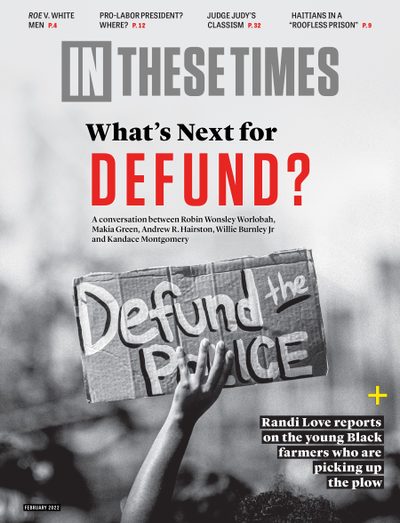Vaccine Apartheid: Straight from the Measles Playbook
Thirty years after the 1990s measles outbreak, it’s still profits over people in Covid-19 America.
In These Times Editors

In 1991, amidst new measles outbreaks, leading medical associations recommended all children receive a second measles-mumps-rubella shot. As In These Times intern Zoe Zolbrod reported, the price of the vaccine rose 300 percent in a decade, straining clinics. Merck, the vaccine’s sole manufacturer, saw its stock shoot up with a 427 percent return.
Merck makes too much money from measles, according to critics. 'As a nation, we cannot allow corporations to make huge profits from vaccines,' said Joseph Liu of the Children’s Defense Fund.
Now, Pfizer and Moderna expect their Covid-19 vaccines to tally more than $20 billion in revenue for 2021, even as the patents they hold have limited vaccine production in poor countries. And healthcare workers across the globe have condemned Big Pharma’s patents as human rights violations — a prioritization of profit over public health.
In 1991, Zoe Zolbrod wrote:
Capitalism is the unspoken reality of American politics. That is the one thing the major parties agree upon: praise capitalism (not too often and preferably by another name), but don’t discuss it. Preclude serious discussion of the central reality of our times. …
When David Anstice, a vice president of a big U.S. pharmaceutical company, declared that “it’s time to make measles a major public health priority again,” it came as no surprise. The sobering statistics on the three-year-old American measles epidemic demand that the country take action against this disease.
But Anstice has good reasons to encourage immunization. His company Merck, Sharp & Dohme is the only manufacturer of a vaccine known as MMR that prevents measles, mumps and rubella. Merck’s prices and stock dividends have soared in the last decade.
Merck makes too much money from measles, according to critics. “As a nation, we cannot allow corporations to make huge profits from vaccines,” said Joseph Liu of the Children’s Defense Fund.
The high price of MMR — combined with a lack of adequate insurance coverage — has forced thousands of parents to turn to public clinics for their children’s vaccination. This influx has both put a strain on the limited clinic staff and has caused vaccine shortages. As a result, many children are simply not receiving the needed doses of MMR.
A growing epidemic: Measles is an entirely preventable disease. Yet in 1989, it affected more than 18,000 American children — the highest number in over a decade and more than ten times the all-time low number in 1983, when only 1,500 had measles. 1990 brought another increase, with more than 25,000 cases reported. Measles can result in deafness, brain damage or death. More than 100 children died in the 1989-1990 epidemic and that total continues to climb.
Although by law American children must receive adequate immunization when they enter school, the Centers for Disease Control and Prevention (CDC) estimates that only 70 to 80 percent of children acquire their proper vaccinations in the preschool years. That number drops to approximately 50 percent in large cities. Vaccinating children at an early age is crucial because most of the children who contract diseases in epidemics such as measles are under the age of five.
Easy money: Ever since the ‘70s when the government first made measles a priority, Merck’s prices have skyrocketed. A single dose of the vaccine now costs more than $22. Public health centers purchase the vaccine at a discounted rate under a contract negotiated by the federal government. Nonetheless, the contracted price has risen 500 percent since 1981 — with taxpayers picking up much of the tab.
At a March 11 hearing of the House Subcommittee on Health and the Environment, chairman Henry Waxman (D-Calif.) was particularly disturbed to discover that Merck-manufactured MMR costs less in Canada and some European countries than it does in the U.S.
“We think the vaccine is a bargain at its current price. It protects against three diseases,” Merck spokesman Gary Bruell told In These Times.
A sick system: The escalating cost of this vaccine — as well as the fact that most insurance policies do not include immunization as part of their basic benefits package — has put a strain on many American families. A growing number of parents who would normally take their children to private physicians are now forced to turn to publicly funded health centers for immunization.
In Dallas County, Texas, for example, the percentage of children referred to clinics for immunization increased 693 percent between 1979 and 1988, according to testimony before Waxman’s subcommittee. Shifts this large are common nationwide. In an era of budget cuts, public providers have a larger base to serve than ever before.
The federal government, through the CDC, provides yearly grants to public health clinics to cover 50 percent of the cost of vaccinations. State and local governments contribute the other 50 percent.
The Children’s Defense Fund, a Washington-based advocacy group, conducted a study which revealed that 70 percent of community and migrant health centers have recently experienced shortages of childhood vaccines. Only half of these clinics could afford to replace these supplies — and they were often forced to purchase them at the higher private-sector rates. Experts say that public health facilities need longer clinic hours, increased staffing and more extensive outreach programs in order to control the measles epidemic. The money that clinics are forced to spend on supplementing their vaccine supply takes away from funds that otherwise go toward improvement of their immunization programs.
An alternative solution: Some physicians advocate removing the manufacture of vaccines from the profit-making sector. “The government should manufacture and distribute all vaccines for free,” said Dr. Richard Biek, chief officer of health for the Chicago Health Department.
Some states have experimented with this approach. Massachusetts, for example, makes its own diphtheria, tetanus and rubella vaccine. The state-manufactured vaccine “does save us quite a bit of money,” said Massachusetts Department of Public Health spokesperson Kate McCormack. “We experience far less occurrence of preventable disease than the national average.”
The number of inner-city children under two who are not immunized is probably higher in the United States than in any Western Hemisphere nation other than Haiti and Bolivia. If these rates do not improve, future epidemics of preventable childhood diseases are almost inevitable. With federal, state and municipal budgets so tight and with so many children uninsured or underinsured, any money designated for public health which ends up lining the pockets of a few stockholders seems cruelly wasted.








